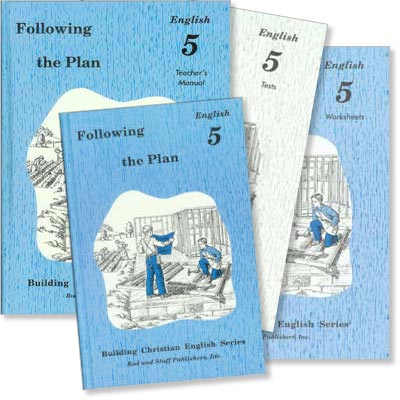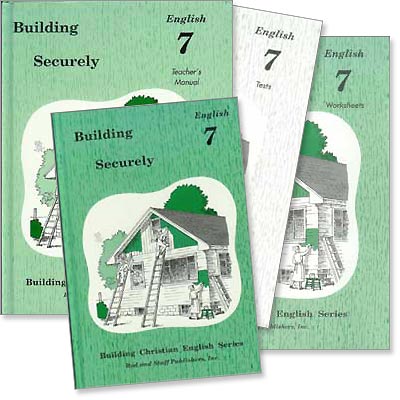.jpg)
Grade 6 English "Progressing with Courage" Set
- 6.3 lbs
Item #1-126--
| This set includes: | # in My Cart | ||
|---|---|---|---|
| Pupil Textbook | $26.10 | ||
| Worksheets | $4.95 | ||
| Tests | $3.95 | ||
| Teacher's Manual | $36.30 | ||
| This set includes: 4 items | |||
English 6 has 132 lessons divided into 11 chapters. The first two chapters deal with understanding sentence types and structure. Chapter 3-6 and Chapters 8-10 focus on the 8 parts of speech. Chapter 7 teaches concepts about capitalization and punctuation. Chapter 11 deals with miscellaneous lessons on the dictionary, Bible reference books, synonyms, antonyms, homonyms, and word families. Interspersed throughout the book are 32 oral and written composition lessons. Continual review is built into the course.
A booklet of 82 worksheets offers additional practice. The sheets may be copied as needed in teaching this English course. The manual has reduced copies of the pupil's text, with the answer keys beside the exercises. For the worksheets and tests, the answers are shown in color on the reproduced pupil's pages. Guidance is given for presenting the lesson to the students. The specific points to be taught are listed, along with further instruction and information for the teacher.
Table of Contents
(Bold indicates Written Composition and Oral English lessons.)
Chapter 1 - Understanding Sentences - Learning About Stories and Directions
- 1. Sentences and Fragments
- 2. The Predicate of a Sentence
- 3. The Subject of a Sentence
- 4. Writing a Story About a Problem
- 5. More About Subjects and Predicates
- 6. Sentences and Clauses
- 7. The Four Sentence Types
- 8. Writing a Set of Directions
- 9. Chapter 1 Review
Chapter 2 - Working With Sentences - Understanding Paragraphs
- 10. Diagramming Sentence Skeletons
- 11. Compound Subjects and Predicates
- 12. Simple and Compound Sentences
- 13. The Structure of a Paragraph
- 14. Avoiding Run-on Errors
- 15. Word Order in Sentences
- 16. Unity and Coherence in a Paragraph
- 17. More About Coherence
- 18. Chapter 2 Review
Chapter 3 - Working With Nouns - Developing Paragraphs
- 19. Recognizing Nouns
- 20. Proper Nouns
- 21. Developing Paragraphs by Using Details
- 22. Nouns With Regular Plural Forms
- 23. Nouns With Irregular Plural Forms
- 24. Developing Paragraphs by Using Examples and Illustrations
- 25. More Plural Nouns
- 26. Possessive Nouns
- 27. Developing Paragraphs by Comparison or Contrast
- 28. Chapter 3 Review
Chapter 4 - Working With Verbs - Writing Outlines
- 29. Verbs
- 30. Principal Parts of Regular Verbs
- 31. Principal Parts of Irregular Verbs
- 32. Simple Verb Tenses
- 33. The Pattern of an Outline
- 34. Present Perfect Tense
- 35. Past Perfect Tense
- 36. Future Perfect Tense
- 37. Sentence and Topical Outlines
- 38. Transitive Verbs and Direct Objects
- 39. Action Verbs That Are Not Transitive
- 40. Transitive Verbs and Indirect Objects
- 41. Forming an Outline From a Composition
- 42. The Linking Verb Be and Predicate Nominatives
- 43. Linking Verbs and Predicate Adjectives
- 44. Linking Verbs or Action Verbs?
- 45. Giving an Oral Book Report
- 46. Chapter 4 Review
Chapter 5 - Using Verbs Correctly - Writing Reports
- 47. Using Lay and Lie
- 48. Using Raise and Rise
- 49. Using Set and Sit
- 50. Taking Notes for a Report
- 51. Using Let and Leave
- 52. Other Troublesome Verbs
- 53. Organizing Your Notes
- 54. Agreement of Subjects and Verbs
- 55. Active and Passive Voice
- 56. Writing a Report: First Draft
- 57. Writing a Report: Second Draft
- 58. More About Active and Passive Voice
- 59. Chapter 5 Review
Chapter 6 - Working With Pronouns - Writing Letters
- 60. Personal Pronouns
- 61. Pronouns in the Nominative Case
- 62. Pronouns in the Objective Case
- 63. Writing a Friendly Letter
- 64. Using Pronouns Correctly
- 65. Possessive Pronouns and Demonstrative Pronouns
- 66. Indefinite Pronouns
- 67. Writing a Business Letter
- 68. Interrogative Pronouns
- 69. Relative Pronouns and Relative Clauses
- 70. Using Relative Pronouns Correctly
- 71. Courtesy and Clarity on the Telephone
- 72. Chapter 6 Review
Chapter 7 - Using Correct Capitalization and Punctuation - Writing Stories
- 73. Using Capital Letters
- 74. Capitalizing Proper Nouns and Proper Adjectives
- 75. The Three Parts of a Story
- 76. End Punctuation
- 77. Direct Quotations
- 78. Direct and Indirect Quotations
- 79. Dialogue in a Story
- 80. Divided Quotations
- 81. Commas in a Series
- 82. Writing a Story: First Draft
- 83. Commas That Set Off Words
- 84. More Practice With Commas
- 85. Writing a Story: Second Draft
- 86. Apostrophes
- 87. Hyphens, Colons, and Semicolons
- 88. Chapter 7 Review
Chapter 8 - Working With Adjectives - Writing Descriptions
- 89. Adjectives
- 90. Predicate Adjectives
- 91. Diagraming Adjectives and Using Appositive Adjectives
- 92. Using Fresh Adjectives
- 93. Writing Descriptions: Observing With Your Five Senses
- 94. Forms of Comparison for Adjectives
- 95. Prepositional Phrases as Adjectives
- 96. Writing Descriptions: Using Comparisons
- 97. Adjective Clauses
- 98. Diagraming Adjective Clauses
- 99. Chapter 8 Review
Chapter 9 - Working With Adverbs - Studying Poetry
- 100. Poetry
- 101. Adverbs
- 102. Adverbs of Degree
- 103. Diagraming Adverbs of Degree
- 104. Rhythm in Poetry
- 105. Forms of Comparison for Adverbs
- 106. Using Good, Well, and Negative Words
- 107. Prepositional Phrases as Adverbs
- 108. Rhyme in Poetry
- 109. Distinguishing Adverbs and Adjectives
- 110. Adverb Clauses
- 111. Diagraming Adverb Clauses
- 112. The Special Language of Poetry
- 113. Simple, Compound, and Complex Sentences
- 114. Chapter 9 Review
Chapter 10 - Using Prepositions, Conjunctions, and Interjections - Communicating Orally
- 115. Prepositions
- 116. Using Prepositions Correctly
- 117. Making an Introduction
- 118. Coordinating Conjunctions
- 119. Subordinating Conjunctions
- 120. Avoiding Misplaced Phrases and Clauses
- 121. Courtesy in Conversation
- 122. Interjections
- 123. Review of the Parts of Speech
- 124. Chapter 10 Review
Chapter 11 - Studying Words - Using Sentence Variety
- 125. Using the Dictionary
- 126. Spellings and Meanings in the Dictionary
- 127. Using a Bible Concordance and a Bible Dictionary
- 128. Sentence Variety in Paragraphs
- 129. Synonyms, Antonyms, and Homonyms
- 130. Word Families
- 131. Chapter 11 Review
- 132. Final Review
Worksheets
Chapter 1
- 1. Sentences and Fragments (Lesson 1)
- 2. The Predicate of a Sentence (Lesson 2)
- 3. The Subject of a Sentence (Lesson 3)
- 4. More About Subjects and Predicates (Lesson 5)
- 5. Sentences and Clauses (Lesson 6)
- 6. The Four Sentence Types (Lesson 7)
Chapter 2
- 7. Diagraming Sentence Skeletons (Lesson 10)
- 8. Compound Subjects and Predicates (Lesson 11)
- 9. Compound Sentences (Lesson 12)
- 10. Avoiding Run-on Errors (Lesson 14)
- 11. Word Order in Sentences (Lesson 15)
- 12. Unity and Coherence in a Paragraph (Lesson 17)
Chapter 3
- 13. Recognizing Nouns (Lesson 19)
- 14. Proper Nouns (Lesson 20)
- 15. Details in Paragraphs (Lesson 21)
- 16. Examples and Illustrations in Paragraphs (Lesson 24)
- 17. Plural Nouns (Lesson 25)
- 18. Possessive Nouns (Lesson 26)
Chapter 4
- 19. Verbs (Lesson 29)
- 20. Principal Parts of Verbs (Lesson 31)
- 21. More Principal Parts (Lesson 31)
- 22. Verb Tenses (Lesson 36)
- 23. Diagraming Direct and Indirect Objects (Lesson 40)
- 24. Outlining (Lesson 41)
- 25. Diagraming Predicate Nominatives and Predicate Adjectives (Lesson 43)
- 26. Diagraming Review (Lesson 44)
Chapter 5
- 27. Lay--Lie, Raise--Rise, and Set--Sit (Lesson 49)
- 28. Let--Leave (Lesson 51)
- 29. Troublesome Verbs (Lesson 52)
- 30. Subject and Verb Agreement (Lesson 54)
- 31. Active and Passive Voice (Lesson 58)
Chapter 6
- 32. Friendly Letters (Lesson 63)
- 33. Using Pronouns Correctly (Lesson 64)
- 34. More Practice With Pronoun Usage (Lesson 64)
- 35. Practice With Pronouns (Lesson 65)
- 36. Possessive, Demonstrative, and Indefinite Pronouns (Lesson 66)
- 37. Business Letters (Lesson 67)
- 38. Possessive, Demonstrative, Indefinite, and Interrogative Pronouns (Lesson 68)
- 39. Relative Pronouns (Lesson 69)
- 40. Using Relative Pronouns (Lesson 70)
Chapter 7
- 41. Using Capital Letters (Lesson 73)
- 42. More Capital Letters (Lesson 74)
- 43. Capital Letters in Proper Nouns and Proper Adjectives (Lesson 74)
- 44. End Punctuation (Lesson 76)
- 45. Direct and Indirect Quotations (Lesson 78)
- 46. Using Dialogue in Stories (Lesson 79)
- 47. More Practice With Direct Quotations (Lesson 80)
- 48. Using Commas in Sentences (Lesson 83)
- 49. More Practice With Commas (Lesson 84)
- 50. Apostrophes (Lesson 86)
- 51. Hyphens, Colons, and Semicolons (Lesson 87)
Chapter 8
- 52. Adjectives (Lesson 89)
- 53. Predicate Adjectives (Lesson 90)
- 54. Diagraming Adjectives and Using Appositive Adjectives (Lesson 91)
- 55. Original, Fresh Adjectives (Lesson 92)
- 56. Forms of Comparison for Adjectives (Lesson 94)
- 57. Prepositional Phrases as Adjectives (Lesson 95)
- 58. Exact Words in Descriptions (Lesson 96)
- 59. Adjective Clauses (Lesson 97)
- 60. Diagraming Adjective Clauses (Lesson 98)
Chapter 9
- 61. Adverbs (Lesson 101)
- 62. Adverbs of Degree (Lesson 102)
- 63. Diagraming Adverbs of Degree (Lesson 103)
- 64. Rhythm in Poetry (Lesson 104)
- 65. Forms of Comparison for Adverbs (Lesson 105)
- 66. Good, Well, and Negative Words (Lesson 106)
- 67. Prepositional Phrases as Adverbs (Lesson 107)
- 68. Rhyme in Poetry (Lesson 108)
- 69. Distinguishing Adverbs and Adjectives (Lesson 109)
- 70. Adverb Clauses (Lesson 111)
- 71. Simple, Compound, and Complex Sentences (Lesson 113)
Chapter 10
- 72. Prepositions (Lesson 115)
- 73. Using Prepositions Correctly (Lesson 116)
- 74. Coordinating Conjunctions (Lesson 118)
- 75. Subordinating Conjunctions (Lesson 119)
- 76. Avoiding Misplaced Phrases and Clauses (Lesson 120)
- 77. Interjections (Lesson 122)
- 78. Review of the Parts of Speech (Lesson 123)
Chapter 11
- 79. Dictionary Practice (Lesson 125)
- 80. More Dictionary Practice (Lesson 126)
- 81. Sentence Variety in Paragraphs (Lesson 128)
- 82. Synonyms, Antonyms, and Homonyms (Lesson 129)









